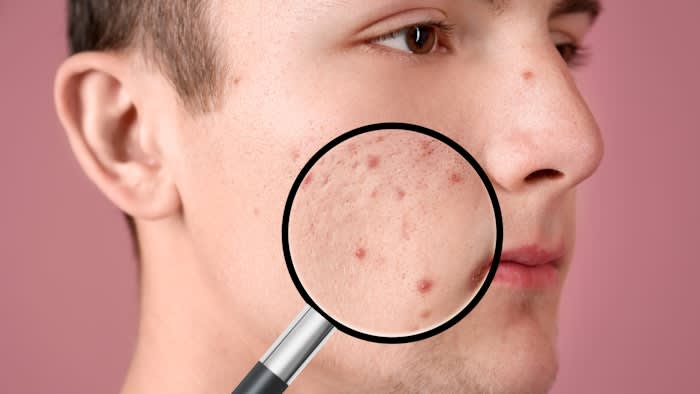Get Your AI Analysis
Personalized skincare insights
Discover your perfect skincare routine with our AI-powered analysis. Get personalized recommendations for glowing, healthy skin.
Start AnalysisFollow Us
Stay updated with the latest skincare tips, trends, and expert advice.
Skin Microbiome Health: The Key to Resolving Persistent Issues
As a skincare veteran with over a decade in this dynamic industry, I’ve witnessed countless trends come and go. But every so often, a scientific revelation emerges that fundamentally shifts our understanding of skin health. The concept of the skin microbiome is precisely one such game-changer. For years, we focused on treating symptoms – blemishes, redness, dryness – often overlooking the intricate ecosystem living on our skin’s surface. If you’ve been battling persistent acne, chronic eczema, or unyielding sensitivity, the answer might not be in another harsh active ingredient, but in nurturing the invisible world beneath your fingertips.
Imagine your skin as a bustling city, teeming with billions of microorganisms – bacteria, fungi, viruses, and mites – all coexisting. This complex community is your skin's microbiome, and its balance is paramount to your skin’s overall health. When this delicate ecosystem is thriving, it acts as a powerful shield, defending against pathogens, regulating inflammation, and maintaining barrier integrity. However, when it falls out of harmony, a state known as dysbiosis, chronic skin issues often arise. It’s time to move beyond surface-level treatments and dive deep into the science of your skin's microscopic guardians.
Understanding Your Skin's Microbiome: A Dynamic Ecosystem
Your skin is not sterile; in fact, it’s one of the most diverse microbial habitats on the planet, second only to your gut. Different areas of your skin – oily, dry, moist – host unique microbial communities. These organisms aren't just bystanders; they’re active participants in maintaining skin homeostasis. They produce antimicrobial peptides, regulate pH, educate your immune system, and even influence how your skin responds to environmental stressors.
Think of your skin’s microbiome as a rainforest. When it’s diverse and balanced, it’s resilient and healthy. When certain species dominate or beneficial ones diminish, the entire ecosystem suffers. Research has shown that a high diversity of skin microbiota correlates with healthier skin. For instance, a 2018 study published in the Journal of Investigative Dermatology highlighted the critical role of microbiome diversity in maintaining skin barrier function and immune modulation. Disruption can lead to a domino effect of inflammation and compromised skin function.

This intricate balance is constantly influenced by various factors: genetics, diet, hygiene practices, environmental exposure, stress levels, and, crucially, the skincare products we use. Many conventional skincare products, while targeting specific issues, inadvertently strip away beneficial bacteria, contributing to dysbiosis rather than resolving the root cause of persistent problems.
The Microbiome's Role in Chronic Skin Conditions
The link between a disrupted microbiome and chronic skin issues is becoming increasingly clear. Let’s explore how dysbiosis contributes to some of the most frustrating skin conditions:
Acne: Beyond Clogged Pores
We once blamed acne solely on oil and clogged pores. Now, we understand the significant role of the bacterium Cutibacterium acnes (formerly Propionibacterium acnes). While C. acnes is a normal resident, certain strains and an imbalance with other bacteria can trigger inflammation, leading to breakouts. Studies indicate that individuals with acne often have a less diverse skin microbiome. A 2017 study in Scientific Reports identified specific differences in the microbial communities of acne-prone skin compared to healthy skin, suggesting that a lack of microbial diversity could contribute to inflammatory acne.
"The shift from 'sterilizing' the skin to 'balancing' it is one of the most profound changes in acne treatment. We're learning that a healthy microbiome can naturally keep inflammatory C. acnes in check."
— Dr. Michelle Henry, Board-Certified Dermatologist
Eczema (Atopic Dermatitis): A Barrier Under Attack
Eczema is characterized by a compromised skin barrier and chronic inflammation. A key player in eczema flare-ups is often an overgrowth of Staphylococcus aureus (S. aureus), a bacterium commonly found on the skin. In healthy individuals, other bacteria keep S. aureus in check. However, in eczema-prone skin, a lack of microbial diversity allows S. aureus to proliferate, producing toxins that worsen inflammation and damage the skin barrier. Research published in Cell Host & Microbe in 2018 detailed how S. aureus exacerbates atopic dermatitis, while beneficial microbes can protect against it.
Sensitivity and Rosacea: The Immune Connection
Persistent redness, stinging, and flushing often indicate sensitive skin or rosacea. While the causes are complex, microbiome dysbiosis is emerging as a contributing factor. An imbalance can lead to a heightened immune response, triggering inflammation and exacerbating symptoms. For rosacea, certain microbes and even mites (like Demodex folliculorum) are thought to play a role, with their presence or waste products potentially stimulating inflammation in susceptible individuals. A compromised barrier, often linked to microbiome disruption, allows irritants to penetrate more easily, leading to chronic sensitivity.
Nurturing Your Microbiome: Microbiome-Friendly Skincare
The good news? You can actively support your skin’s microbiome. The right approach involves a blend of microbiome-friendly skincare and holistic lifestyle choices. This isn't about eradicating all bacteria, but about fostering a diverse, balanced environment where beneficial microbes can thrive.
Prebiotic Skincare: Feeding the Good Guys
Prebiotics are like fertilizers for your skin’s beneficial bacteria. They are non-living ingredients, often sugars or plant extracts, that serve as food for the good microbes already present on your skin, helping them proliferate and outcompete harmful ones. Ingredients like inulin, fructooligosaccharides, and alpha-glucan oligosaccharides are common examples.
- Product Recommendation: GALLINÉE Face Vinegar uses prebiotics and postbiotics (lactic acid) to gently tone and rebalance the skin's pH, creating an optimal environment for beneficial bacteria.
- Product Recommendation: Biossance Squalane + Prebiotic Toning Mist delivers potent prebiotics to help fortify the skin's barrier and support a healthy flora.
Probiotic Skincare: Introducing Beneficial Strains
Probiotics in skincare refer to products containing live beneficial bacteria or their non-viable components (lysates, ferments). While live bacteria face challenges in shelf stability and penetration, their extracts or 'lysates' have shown promise. These ingredients can help calm inflammation, strengthen the skin barrier, and even produce antimicrobial peptides.
- Product Recommendation: TULA Skincare is a brand built on probiotics, offering a range of cleansers, serums, and moisturizers featuring probiotic extracts to balance and nourish the skin.
- Product Recommendation: Mother Dirt AO+ Restorative Mist contains a live, beneficial bacteria (AOB, Ammonia-Oxidizing Bacteria) designed to reintroduce lost bacteria to the skin, promoting a healthier microbiome.
Postbiotic Skincare: The Metabolite Powerhouses
Postbiotics are the beneficial byproducts produced by probiotics, such as enzymes, peptides, and organic acids (like lactic acid). These 'waste products' actually offer significant benefits, including anti-inflammatory effects, barrier strengthening, and antioxidant protection, without the stability concerns of live bacteria. They are increasingly recognized for their ability to signal to skin cells and support overall skin health.
- Product Recommendation: Skinfix Barrier+ Triple Lipid-Peptide Cream, while not explicitly labeled 'postbiotic,' is rich in ceramides, fatty acids, and peptides that mimic and support a healthy skin barrier, which is crucial for a balanced microbiome. Many fermented ingredients also produce postbiotics, making them key for barrier support.
- Product Recommendation: Estée Lauder Advanced Night Repair Serum uses Bifida Ferment Lysate, a postbiotic ingredient known for its ability to soothe skin and reduce signs of sensitivity.

"Incorporating microbiome-friendly products isn't just a trend; it's a fundamental shift towards understanding skin health at its most intricate level. It's about working with your body, not against it."
— Dr. Whitney Bowe, Integrative Dermatologist and Author
Holistic Approach: Lifestyle & Diet for Microbiome Health
Skincare products are just one piece of the puzzle. Your daily habits profoundly impact your skin's microbial residents.
- Gentle Cleansing: Avoid harsh cleansers that strip natural oils and disrupt the skin's pH. Opt for sulfate-free, pH-balanced formulas. Example: La Roche-Posay Toleriane Hydrating Gentle Cleanser.
- Mindful Exfoliation: Over-exfoliation can damage the skin barrier, making it vulnerable. Use chemical exfoliants (AHAs/BHAs) sparingly and gently.
- Dietary Choices: A balanced diet rich in fiber, fermented foods (kimchi, sauerkraut, kefir), and omega-3 fatty acids supports both gut and skin microbiome health. The gut-skin axis is a powerful connection!
- Stress Management: Chronic stress can impact your immune system and inflammatory responses, indirectly affecting your skin's microbiome. Incorporate practices like meditation, yoga, or spending time in nature.
- Adequate Sleep: Sleep deprivation compromises skin repair and immune function, creating an environment less conducive to a healthy microbiome.
- Avoid Over-Sanitizing: Excessive use of antibacterial soaps can eliminate beneficial bacteria along with harmful ones.
Building Your Microbiome-Balanced Routine: Step-by-Step
Transitioning to a microbiome-friendly routine doesn't have to be complicated. Here's a simplified guide:
Morning Routine:
- Gentle Cleanse: Rinse with water or use a mild, pH-balanced cleanser. (e.g., Avene Tolerance Extremely Gentle Cleanser).
- Prebiotic/Probiotic Treatment: Apply a microbiome-balancing serum or mist. (e.g., Biossance Squalane + Prebiotic Toning Mist).
- Hydrate & Protect: Follow with a barrier-supporting moisturizer and a broad-spectrum SPF. (e.g., CeraVe PM Facial Moisturizing Lotion and EltaMD UV Clear Broad-Spectrum SPF 46).
Evening Routine:
- Double Cleanse (if wearing makeup/SPF): Start with an oil or balm cleanser, then follow with a gentle, hydrating cleanser. (e.g., cocokind oil to milk cleanser followed by Kiehl's Ultra Facial Cleanser).
- Targeted Treatment (optional): If using actives like retinoids, apply after cleansing and before your microbiome-focused steps, ensuring they are well-tolerated and not causing irritation.
- Prebiotic/Probiotic/Postbiotic Treatment: Apply a serum or treatment focused on microbiome health. (e.g., TULA Skincare 24-7 Moisture Hydrating Day & Night Cream or Estée Lauder Advanced Night Repair Serum).
- Nourish & Restore: Lock everything in with a rich, barrier-repairing cream. (e.g., Skinfix Barrier+ Triple Lipid-Peptide Cream).

Remember, consistency is key. Results won't happen overnight, but over time, you’ll notice your skin becoming more resilient, less reactive, and clearer. By understanding and nurturing your skin's microbiome, you’re not just treating symptoms; you're building a foundation for lasting skin health.
